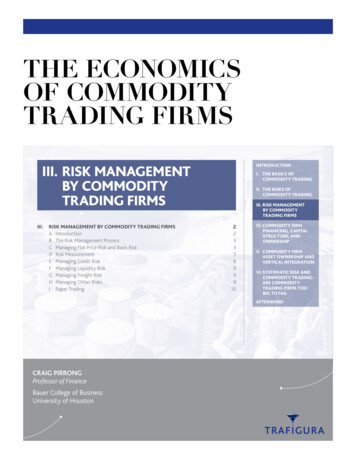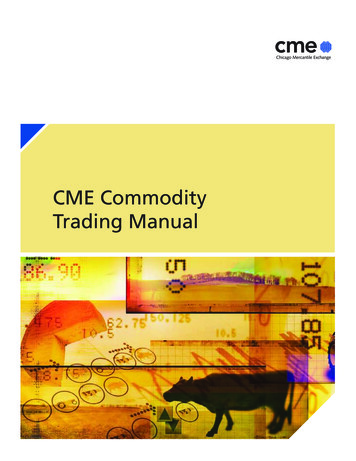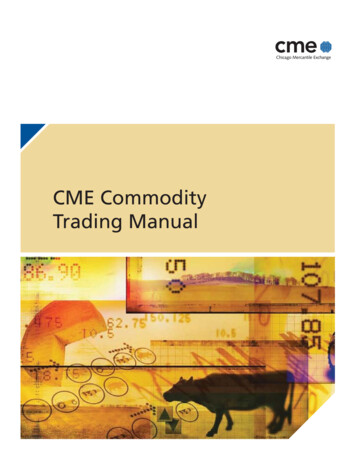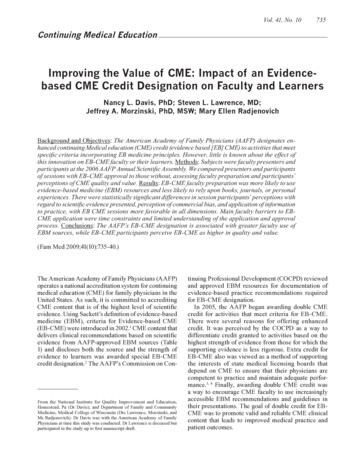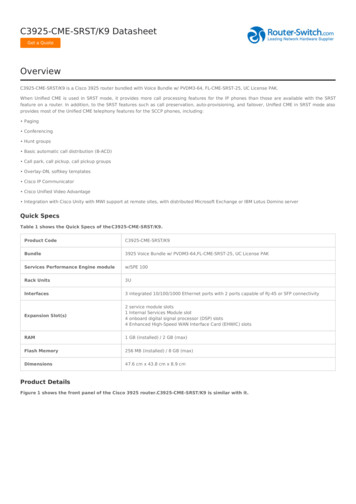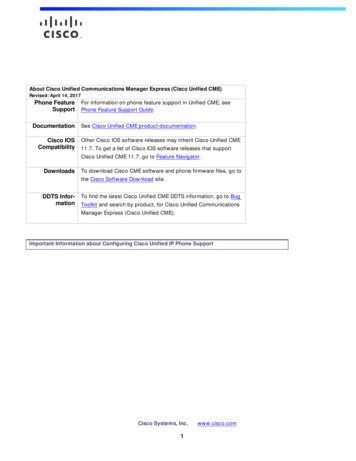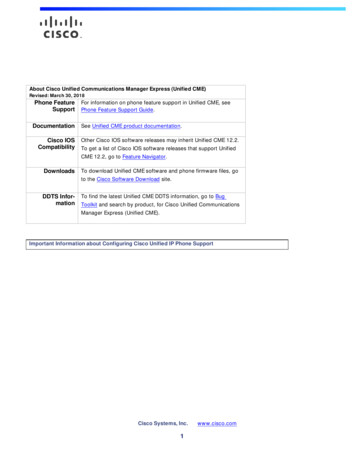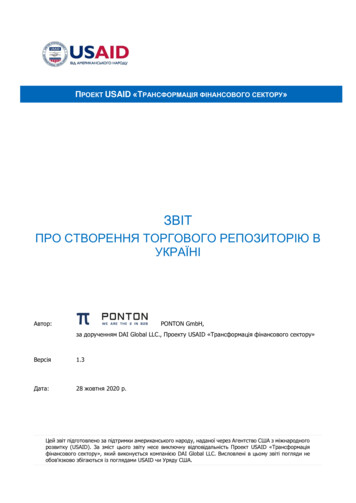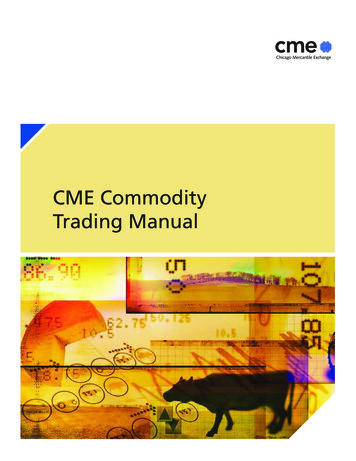
Transcription
CME CommodityTrading Manual
To the Reader.This book was originally designed as a guide for teachers of highschool agricultural education programs. It contained supplementalmaterials and study pages, and was one of the first organizedcommodity marketing courses for high school students.The original course was funded by Chicago Mercantile Exchange(CME) in conjunction with the National FFA Foundation and theStewart-Peterson Advisory Group. Several individuals contributed tothe project, including high school instructors to whom CME is grateful.The success of the course in the schools has prompted CME to redesignthe book as a textbook, revise and update it once again, and make itavailable to anyone who wishes to gain a comprehensive introductionto commodity marketing.
Table of ContentsChapter OneMARKETING BASICS . . . . . . . . . . . . . . . . . . . . . . . . . . . . . . . . . . . . . . . . . . . . . 1An overview of the futures market and its development;marketing alternativesChapter TwoFUTURES MARKETS . . . . . . . . . . . . . . . . . . . . . . . . . . . . . . . . . . . . . . . . . . . . . 13How producers use the futures market for the sale orpurchase of commoditiesChapter ThreeTHE BROKERAGE ACCOUNT . . . . . . . . . . . . . . . . . . . . . . . . . . . . . . . . . . . . . . 27Practical information regarding choosing a broker andplacing ordersChapter FourSUPPLY AND DEMAND . . . . . . . . . . . . . . . . . . . . . . . . . . . . . . . . . . . . . . . . . . 37Factors that affect supply and demand and the impacton projecting prices for commoditiesChapter FiveANALYTICAL TOOLS . . . . . . . . . . . . . . . . . . . . . . . . . . . . . . . . . . . . . . . . . . . . 49Introduction to technical analysis and chartingChapter SixOPTIONS TERMS . . . . . . . . . . . . . . . . . . . . . . . . . . . . . . . . . . . . . . . . . . . . . . . 63Introduction to options and how to use them to hedge asale or purchaseChapter SevenOPTIONS STRATEGIES . . . . . . . . . . . . . . . . . . . . . . . . . . . . . . . . . . . . . . . . . . . 77Selling and purchasing strategiesChapter EightMARKETING MATH . . . . . . . . . . . . . . . . . . . . . . . . . . . . . . . . . . . . . . . . . . . . . 91Answer Keys for Chapter Exercises . . . . . . . . . . . . . . . . . . . . . . . . . . . . . . . . . . . . . . . 105Glossary . . . . . . . . . . . . . . . . . . . . . . . . . . . . . . . . . . . . . . . . . . . . . . . . . . . . . . . . . . . . . . . . . . . . . . . . 107
Chapter One Marketing BasicsChapter 1Marketing BasicsChapter One Objectives To understand the evolution of the commodity marketplaceTo understand the role commodity exchanges play in the marketTo learn the four marketing alternatives and to be able to describe their advantages anddisadvantagesTo introduce the basic vocabulary of the commodities trading marketplaceTo learn about cash sales and forward contractsMarketing ChoicesProducers have four marketing alternatives.If you are involved in the production of agricultural commodities, you can price your commoditiesusing one or more combinations of these four alternatives: Cash salesForward contractsFutures contractsOptions on futures contracts1. With cash sales you deliver your crop or livestock to the cash markets (such as the grainelevator or meat packer) and receive the price for the day. You get cash right away, and thetransaction is easy to complete. But using this alternative, you have only one chance to sell.You take what you can get. This is actually one of the riskiest marketing alternatives forproducers.2. A forward contract is negotiated now for delivery later. It is easy to understand. You enter acontract with the buyer who agrees to buy a specified quantity and quality of the commodityat a specified price at the time of delivery. The price is locked in, and you are protected if pricesfall. However, you cannot take advantage of price increases, and you must deliver the specifiedamount, even if you have a crop failure. Both parties have some risk that the other will nothonor the contract.1
Commodity MarketingForwardcontractA private, cash market agreement between a buyer and seller for the future delivery of acommodity at an agreed price. In contrast to futures contracts, forward contracts are notstandardized and not transferable.3. A futures contract is an agreement to buy or sell a commodity at a date in the future. You buyor sell through a brokerage firm that transacts the trade for you. Once you are set up with afirm, it is as easy as a phone call to make a trade. You must deposit a performance bond (asmall percentage of the contract value) with the brokerage firm to guarantee any loss you mayincur on the futures contract. If the value of the contract goes against your position, you willbe asked to deposit more money. You also pay a broker a commission for every contract traded.(You will learn more about futures later in the chapter.)FuturescontractAn obligation to deliver or to receive a specified quantity and grade of a commodityduring a designated month at the designated price. Each futures contract is standardizedby the exchange and specifies commodity, quality, quantity, delivery date and settlement.Hedging is selling or buying a futures contract as a temporary substitute for selling or buying thecommodity at a later date. For example, if you have a commodity to sell at a later date, you can sell afutures contract now. If prices fall, you sell your actual commodity at a lower cash price, but realize again in the futures market by buying a futures contract at a lower price than you sold. If prices rise,your higher price in the cash market covers the loss when you buy a futures contract at a higher pricethan you sold. This may be considered a pure hedge, or a replacement hedge. It minimizes your riskand often earns you more than the forward contract price.Hedging1 - Taking a position in a futures market opposite to a position held in the cash marketto minimize the risk of financial loss from an adverse price change. 2 - A purchase or saleof futures as a temporary substitute for a cash transaction which will occur later.4. Options on futures contracts are traded at futures exchanges too. (You will learn more aboutoptions in Chapter Six.) An option is the right, but not the obligation, to buy or sell a futurescontract at a specified price. You pay a premium when you buy an option, and you pay acommission to the broker.For example, if you buy a put option and prices rise, you can let the option expire and sell inthe cash markets at a higher price. If prices fall, you can protect yourself against the low cashprice by: 2Offsetting the option (sell the same type of option).Exercising the option (exchange the option for the underlying futures contract).
Chapter One Marketing BasicsOptionThe right, but not the obligation, to sell or buy the underlying (in this case, a futurescontract) at a specified price on or before a certain expiration date. There are twotypes of options: call options and put options. Each offers an opportunity to takeadvantage of futures price moves without actually having a futures position.Marketing AlternativeAdvantagesDisadvantagesCash sales Easy to transactImmediate paymentNo set quantity Maximize riskNo price protectionLess flexibleForward contract Easy to understandFlexible quantityLocked-in priceMinimize risk Must deliver in fullOpportunity loss if prices riseFutures contract Easy to enter/exitMinimize riskOften better prices thanforward contracts Opportunity loss if prices riseCommission costPerformance bond callsSet quantitiesOptions contract Price protectionMinimize riskBenefit if prices riseEasy to enter/exit Premium costSet quantitiesCommission costCash SalesCash sales involve risk for the producer.As a producer of corn, wheat, soybeans, cattle, hogs or dairy products, you will eventually sell yourcommodity in the cash markets. You can sell directly in your local markets or negotiate a forwardcontract for sale at a later date. Even if you sell futures contracts or buy options to sell futures, you willclose out your position and sell your commodity in the cash markets. Very few futures contracts areactually delivered.If you are selling grain or livestock on a cash basis, the terms are negotiated when you bring in thegrain or livestock. The price is established then and there, and you make immediate delivery andreceive payment. This type of sale occurs at elevators, terminals, packing houses and auction markets.3
Commodity MarketingYou can choose when to sell grains in the cash market. You can sell at harvest or store the grain untillater when you expect prices to be better. Because of storage costs, there is risk involved in waiting forprices to rise. For example, if it costs you 0.05/bushel per month to store soybeans, then the price fourmonths from now would have to be more than 0.20/bushel ( 0.05 x 4 months) better than harvestprices for you to gain any advantage over selling at harvest.You can also make a cash sale with a deferred pricing agreement. You deliver the commodity andagree with the buyer to price it at a later time. For example, you may deliver corn in October and priceit at any time between then and March. In this way, you transfer the physical risk of having the cornand the storage cost, and you may be able to get a higher price for the corn. Of course, there is theadded risk of the elevator’s financial stability.Forward ContractsYou can negotiate a forward contract with your local merchant for future delivery of your crop orlivestock. You and the buyer agree on quantity, quality, delivery time, location and price. This shouldbe a written contract. Once you enter into this contract, you eliminate the risk of falling prices.However, if prices go higher at delivery time, you’ll still receive the negotiated price.When you make delivery, it will be inspected before payment is made. There may be a premium ordiscount in price if quality or quantity vary.Cash Markets Cash Sales/Deferred Pricing Forward Pricing/Basis ContractA basis contract is another method of forward contracting. In this case, you lock in a basis relating to aspecified futures contract. When you deliver, the price you receive is the current price of the specifiedfutures contract adjusted by the basis you agreed upon. For example, if a basis of 0.20 under wasspecified in the contract and the futures price is 3.04 on the delivery date, then the cash price youreceive is 2.84 ( 3.04 - 0.20 2.84). You need to know the local basis patterns before entering intothis type of forward contract.BasisThe relationship of the local cash market price and futures market price is called basis. The value ofbasis is calculated by subtracting the price of the nearby futures contract from the local cash marketprice. For example, if the cash price for corn is 2.80 and the futures price is 3.00, then the basis is 0.20 under ( 2.80 – 3.00 - 0.20). With a cash price of 2.95 and a futures price of 2.90, the basis is 0.05 over ( 2.95 – 2.90 0.05).Basis Cash Price - Futures Price4
Chapter One Marketing BasicsBasisThe difference between the spot or cash price and the futures price of the same or arelated commodity. Basis is usually computed to the near future, and may representdifferent time periods, product forms, qualities and locations. The local cash market priceminus the price of the nearby futures contract. A private, cash market agreement betweena buyer and seller for the future delivery of a commodity at an agreed price. In contrast tofutures contracts, forward contracts are not standardized and not transferable.Storable commodity futures prices reflect the cost of delivering a commodity to a specific place. Cashprices reflect the cost of delivering (perhaps a different quality) to a different place. These costsinclude transportation, carrying charges such as storage costs for grain, and marketing costs such asweight shrinkage for livestock. Basis reflects supply and demand for a given commodity in a givenlocation along with the cost of delivering (perhaps a different quality) to a different place.NOTE: In your area, people may consider basis to be futures minus cash. However, in this course, as inmost works on futures, the formula used is cash minus futures.Basis Basis is the local cash price for a commodity minus the futures market price.When basis becomes more positive, it is said to strengthen.When basis becomes less positive, it is said to weaken.Basis varies from one location to another. Depending on the circumstances of the local market, thebasis may be consistently positive (over) or negative (under). Each local market has its own pattern.Storable commodity basis also changes during the life of the futures contract. Basis tends to start wide,but the threat of delivery on the futures contract generally causes the basis to narrow. That is, thefutures price moves closer to the delivery point cash price during the delivery month.Evolution of FuturesThe first futures contracts were established in Chicago.No one person invented futures trading, and no one invented the futures exchanges at which thistrading takes place. The futures market evolved out of the circumstances of the market and the needto improve the existing marketing system. This evolution took place over a long period of time fromthe practice of forward contracting.It all started in Chicago. Chicago was a growing city in the 1830s and a center for the sale of grainsgrown nearby to be shipped to the East.In the 1840s, farmers spread over the countryside farther and farther away from Chicago where saleswere transacted. Local merchants began to buy corn from farmers for subsequent sale in Chicago.5
Commodity MarketingBy the early 1850s, the local merchants began to sell corn to the Chicago merchants on time contracts,or forward contracts, to minimize their risk. The farmers risked not having anyone buy their corn orhaving to sell at rock-bottom prices. The merchants risked not having any corn to buy or having to buyat sky-high prices. The forward contract set forth the amount of corn to be sold at a future date at anagreed-upon price. Forward contracts in wheat also started in the early 1850s.As soon as the forward contract became the usual way of doing business, speculators appeared. Theydid not intend to buy or sell the commodity. Instead, they traded contracts in hope of making a profit.Speculation itself became a business activity. Contracts could change hands many times before theactual delivery of the corn. During this time, contracts were negotiated and traded in public squaresand on street curbs.The Board of Trade of the City of Chicago (CBOT) had been organized in 1848 with the intention topromote commerce. In 1859, the state of Illinois authorized the Board of Trade to develop qualitystandards and to measure, gauge, weigh and inspect grain. This made the process of buying andselling grain and the trading of forward contracts more efficient. Trading moved from the street to ameeting place that the Board of Trade provided.At first, there was little control over the trading of forward contracts. Sometimes, people disappearedwhen the time came to settle contracts, and others could not pay. In 1865, the CBOT issued generalrules setting forth: A requirement for a margin, or good faith, depositStandardized contract terms for quantity and quality of the commodity and delivery proceduresPayment termsThey called these standardized contracts futures contracts. All the ingredients for futures trading werenow in place. In the years following, the Board gradually extended its control and developed furtherrules, driven by disputes and problems that arose.There were as many as 1600 commodity exchanges formed in the 1880s.In 1874, merchants formed the Chicago Produce Exchange, which dealt primarily with butter, eggs,poultry and other farm products. It was later named the Chicago Butter and Egg Board. In 1919, itbecame the Chicago Mercantile Exchange (CME).Across the country a similar evolution was taking place. Forward contracts in cotton were reported inNew York in the 1850s, although it would be 20 years before the New York Cotton Exchange wasorganized. New Orleans started its own cotton exchange in 1870. Grain exchanges began inMinneapolis, Duluth, Milwaukee, Omaha, Kansas City, St. Louis, Toledo, Baltimore, San Francisco andNew York.Many commodity exchanges have been organized since 1848. Some are still here today. Others haveclosed or merged with other exchanges.6
Chapter One Marketing BasicsFutures contracts have evolved over the years. CME developed such features as cash settlement (nophysical delivery is involved; only the change in price is settled at the contract maturity) and electronictrading. But successful futures contracts – those with adequate volume for both hedgers andspeculators – generally have certain features in common.The underlying cash commodity market should be large, with a substantial deliverable supply (toprevent market manipulation) and easily available, up-to-date price information. The commodityshould also be fungible, meaning that the units of the commodity should be very similar. There is verylittle difference between one bushel of corn and another. The commodity should also have substantialprice volatility, because it is the hedger’s need for risk management that ultimately fuels trading.Futures trading evolved from the circumstances and needs of the markets, and it is still changing today.Some commodities have been traded for over a hundred years, some have been dropped from theexchanges for lack of trading activity, and others have been added only recently. For example, CMEintroduced futures based on live animals in the 1960s (cattle and hogs), currency futures in the 1970s,stock index and interest rate futures in the 1980s and many new contracts in the 1990s, including milk,butter and cheese futures. CME continues to add contracts: most recently, options and futures on realestate and weather.Some CME Weather contracts are based on temperature differences from an average, some on thenumber of days frost occurs, and others on the amount of snowfall in a given location. Derivativeproducts are also traded on economic announcements, such as economic growth and unemploymentstatistics.Futures trading is a global industry, and CME futures can be traded electronically outside the UnitedStates in more than 80 countries and foreign territories through approximately 110 direct connectionsto the CME Globex electronic trading platform.RegulationBoth the exchanges and the government play a role in regulating futures market activity.The rules set forth by the CBOT in 1865 and by the other developing exchanges across the countryformalized the practice of futures trading, but by no means got rid of problems associated with thisspeculative activity. In the years to follow there were situations of fraud and attempts to manipulatethe market. As new problems arose, the commodity exchanges continued to refine the rules ofbehavior required of their members.Federal Regulation Grain Futures Act of 1922 Commodity Exchange Act of 1936 Commodity Futures Trading Act of 1974, birth of CFTC Commodity Exchange Act of 1981, birth of NFA Commodity Futures Modernization Act of 20007
Commodity MarketingGovernment initially took a negative view. Outwardly, few of the benefits of futures trading wereapparent. It looked like feverish speculation, spectacular price fluctuations and trouble for farmers. For50 years from the 1860s onward, bills were introduced in both state legislatures and the FederalCongress to abolish or tax futures trading out of existence, but did not pass. Opposition was highestduring periods of low prices and lowest when prices rose. Over time, the importance of futures tradingto the development of agriculture and trade gradually became apparent.The Grain Futures Act of 1922 was the first federal law regulating futures trading. It allowed thegovernment some control over the exchanges by requiring them to be licensed and to prevent pricemanipulation by their members. It also provided for a supply of continuous trading information. ThisAct was amended and became the Commodity Exchange Act (CEA) of 1936. It dealt with marketabuses by traders and commission merchants as well as the exchange members. Price manipulationbecame a criminal offense. More amendments were made over the years.The Commodity Futures Trading Act of 1974 created the Commodity Futures Trading Commission(CFTC), the independent body that oversees all futures trading in the United States. Although thefutures exchanges were essentially self-regulating, they had to obtain CFTC approval for any regulatorychanges or for the introduction of new futures and Commodity Marketing contracts. They also had tohave trading rules, contract terms and disciplinary procedures approved by the CFTC.The National Futures Association (NFA) was incorporated under the Commodity Exchange Act of 1981.Its purpose was to regulate the activities of its members – brokerage houses and their agents. FuturesCommission Merchants (FCMs), brokerage firms that accept futures orders and funds from the public,must be registered with the NFA.The Commodity Futures Modernization Act (CFMA) amended the CEA so that the amount of CFTCregulation depends on the kind of market participant and on the type of futures contract traded.Under CFMA, a retail investor has more CFTC protection than a large Wall Street investment bank.Similarly, futures contracts that are more susceptible to market manipulation, like commodities, aretraded on organized futures exchanges such as CME where the exchange and the CFTC can monitoractivity. Other sorts of contracts used primarily by big institutions, such as oil and metals, are regulatedmore lightly. Another purpose of the CFMA was to make it easier for exchanges to innovate andintroduce new contracts.The Exchanges TodayThe exchanges provide the place and the rules under which trading takes place.A futures exchange formulates rules for trading of futures contracts, provides a place to trade andsupervises trading practices. Its members are people whose business is trading. There are nine futuresexchanges in the United States as of January 2006.There are many different products traded at the nine futures exchanges. Although agriculturalcommodities were the only ones traded when the futures markets first began, today there is moreemphasis on the financial and global markets.8
Chapter One Marketing BasicsChicago Board of TradeChicago Mercantile ExchangeOneChicagoMinneapolis Grain ExchangeKansas City Board of TradePhiladelphia Board of Trade (PHLX)InterContinental ExchangeNew York Board of TradeNew York Mercantile ExchangeCommodity Categories Grains and oilseeds: Wheat, corn, oats, soybeans, soybean meal, soybean oil, barley, riceLivestock and meat: Cattle, feeder cattle, hogs, pork belliesDairy products: Milk, butter, nonfat dry milkFoods and fibers: Including sugar, cocoa, coffee, cottonWood and petroleum: Including lumber, crude oil, heating oil, gasolineMetals: Including gold, silver, copperForeign currencies: Including the British pound, Brazilian real, and the euroInterest rate products: Including CME Eurodollars, T-bills, T-bonds, T-notesIndex products: Including the S&P 500 Index, NASDAQ-100 Index, Goldman-Sachs CommodityIndex , S&P/Case-Shiller Home Price Indices Energy: Including oil, natural gas, electricityEvents: Including U.S. unemployment rate, Eurozone inflation, GDPFutures exchanges continue to evolve as well. Some futures exchanges have merged with stockexchanges (such as the Philadelphia Board of Trade with the Philadelphia Stock Exchange, or PHLX) tooffer a range of financial assets and derivatives for trading. There is also great interest in mergingfutures exchanges in different countries to increase cross-border trading opportunities. And theInterContinental Exchange (ICE) has no trading floor; it is an all-electronic futures exchange with itsprimary server located in Atlanta, Georgia.9
Commodity MarketingThe ParticipantsThere are various participants involved in futures and options trading: A futures exchange provides a place and time for trading and the rules under which tradingtakes place. It establishes the terms of the standardized contracts that are traded. Itdisseminates price and market information and provides the mechanics to guarantee contractsettlement and delivery.Clearing firms are responsible for the day-to-day settlement of all customer accounts at futuresexchanges. They act as a third party to all trades, serving as buyer to every seller and seller toevery buyer, and guarantor of all contracts.An AnalogyThe exchanges provide the playing field andequipment, write the rules, and act as referee, headlinesman, and field judges, but do not handle thefootball. They do not trade and neither win nor lose.”Thomas HieronymusEconomics of Futures Trading, 1971Traders on the floor and/or screenBrokers Trade for customers ofvarious brokerages Brokerage firms place orders to buy and sell futures and options contracts for companies orindividuals. Firms earn a commission on all transactions. Everyone who trades must have anaccount with a brokerage firm.Floor traders are members of an exchange. They buy and sell contracts on the floor of theexchange in open outcry (and via electronic trading for some contracts). All trading is donepublicly so each trader has a fair chance to buy and sell. There are two types of traders on anexchange floor: 10Traders Trade for themselvesor accounts theycontrol-can bescalpers, day tradersor position tradersFloor traders: People who trade for themselves or the accounts they control, using differenttrading strategies. Scalpers make a living by buying and then quickly selling, or vice versa,at fractions of a cent profit. Day traders buy and sell contracts throughout the day, closingtheir position before the end of trading. Position traders, who take relatively largepositions in the market, may hold their positions over a long period of time.
Chapter One Marketing Basics Floor brokers: Floor brokers act as agents for customers by trading futures and optionscontracts on the floor of an exchange for other people.E-traders: With the introduction of CME Globex and other electronic trading platforms, tradersno longer need to be physically present on the floor. CME Globex is linked to the CME openoutcry floor system, so electronic trading can take place anywhere there is a CME Globexterminal (and at any time, including after regular floor trading hours). While electronic traderscan choose to trade alone, others come together in small, off-floor areas called trading arcades,which gives electronic traders some of the interaction available on the floor and the chance toshare the overhead expense of computers and information feeds.Commodity Pool Operators: CPOs pool investors’ funds and operate much like a mutual fundsfor stocks. Because these funds can make large trades, they can have a significant impact onindividual futures markets and on price trends.Speculators try to make money by buying and selling futures and options. They speculate thatprices will change to their advantage. They do not intend to make or take delivery of thecommodities. Speculators assume the risk in the market and provide liquidity.Hedgers are people or firms who use futures or options as a substitute for buying and sellingthe actual commodity. They buy and sell contracts to offset the risk of changing prices in thecash markets. Hedgers use futures or options to transfer risk to speculators.The Futures MarketHedgers Avoid risk Protect againstprice changesSpeculators Accept risk Try to profit fromprice changes11
Commodity MarketingChapter One Exercise1. You sell 4,000 bushels of soybeans in the cash market at a price of 5.80/bushel. What is the totalvalue of the sale?2. You buy 10,000 bushels of corn in the cash market at a price of 2.50/bushel. What is the totalprice of the purchase?3. You are planning to sell four 250-pound hogs at 44.00/cwt. How much will you receive forthe sale?4. You are planning to buy three 750-pound feeder steers at 62.50/cwt. How much will you pay forthe purchase?5. If the cash price is 5.10 and basis is 0.15 under, what is the nearby futures price?6. If the nearby futures price is 68.00 and the cash price is 69.50, what is the basis?7. If the cash price is 2.80 and the nearby futures price is 2.95, what is the basis?8. If the nearby futures price is 54.00/cwt and the basis is 1.00 under, what is the cash price?9. If a basis of 0.35 under was specified in a basis contract and the futures price is 3.40/bushel ondelivery date, what is the cash price you receive on delivery?10. Today’s cash price for corn is 2.80/bushel. You can store your corn for two months at a cost of 0.03/bushel/month. What selling price do you need after two months to break even?12
Chapter Two Futures MarketsChapter 2Futures MarketsChapter Two Objectives ToToToToTounderstand how producers can use the futures market as protection against price riskunderstand the principles of hedginglearn the mechanics of short and long hedgesunderstand the reasons and ways that producers use the futures markets to hedgebe able to calculate a simple hedgeFutures ContractsA futures contract specifies everything but the price.The activity of trading standardized contracts for commodities to be delivered at a later date began inthe U.S. more than 130 years ago in Chicago. Today, the futures market provides the opportunity forproducers to lock in prices for their commodities and for speculators to trade for profit.A futures contract is a standardized agreement to buy or sell a commodity at a date in the future. Thefutures contract specifies: Commodity (live
CME Commodity Trading Manual. This book was originally designed as a guide for teachers of high school agricultural education programs. It contained supplemental materials and study pages, and was one of the first organized commodity marketing courses for high school students. The original course was funded by Chicago Mercantile Exchange (CME .
